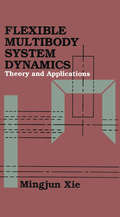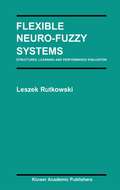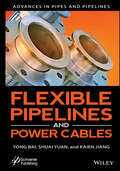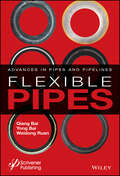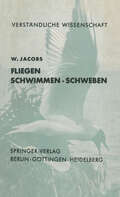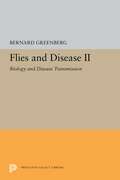- Table View
- List View
Flexible Multibody System Dynamics: Theory And Applications
by Mingjun XieThis volume examines the theoretical and practical needs on the subject of multibody system dynamics with emphasis on flexible systems and engineering applications. lt focuses on developing an all purpose algorithm for the dynamic simulation of flexible tree-like systems making use of matrix representation at all levels. The book covers new theories with engineering applications involved in broad fields which include; civil engineering, aerospace and robotics, as well as general and mechanical engineering. The applications include high temperature conditions, time variant contact conditions, biosystem analysis, vibration minimization and control.
Flexible Multibody System Dynamics: Theory And Applications
by Mingjun XieThis volume examines the theoretical and practical needs on the subject of multibody system dynamics with emphasis on flexible systems and engineering applications. lt focuses on developing an all purpose algorithm for the dynamic simulation of flexible tree-like systems making use of matrix representation at all levels. The book covers new theories with engineering applications involved in broad fields which include; civil engineering, aerospace and robotics, as well as general and mechanical engineering. The applications include high temperature conditions, time variant contact conditions, biosystem analysis, vibration minimization and control.
Flexible Neuro-Fuzzy Systems: Structures, Learning and Performance Evaluation (The Springer International Series in Engineering and Computer Science #771)
by Leszek RutkowskiFlexible Neuro-Fuzzy Systems is the first professional literature about the new class of powerful, flexible fuzzy systems. The author incorporates various flexibility parameters to the construction of neuro-fuzzy systems. This approach dramatically improves their performance, allowing the systems to perfectly represent the pattern encoded in data. Flexible Neuro-Fuzzy Systems is the only book that proposes a flexible approach to fuzzy modeling and fills the gap in existing literature. This book introduces new fuzzy systems which outperform previous approaches to system modeling and classification, and has the following features: -Provides a framework for unification, construction and development of neuro-fuzzy systems; -Presents complete algorithms in a systematic and structured fashion, facilitating understanding and implementation, -Covers not only advanced topics but also fundamentals of fuzzy sets, -Includes problems and exercises following each chapter, -Illustrates the results on a wide variety of simulations, -Provides tools for possible applications in business and economics, medicine and bioengineering, automatic control, robotics and civil engineering.
Flexible Pipelines and Power Cables (Advances in Pipes and Pipelines)
by Yong Bai Shuai Yuan Kaien JiangFlexible Pipelines and Power Cables (Advances in Pipes and Pipelines)
by Yong Bai Shuai Yuan Kaien JiangFlexible Pipes: Advances in Pipes and Pipelines
by Qiang Bai Yong Bai Weidong RuanRecent changes in the codes for building pipelines has led to a boom in the production of new materials that can be used in flexible pipes. With the use of polymers, steel, and other new materials and variations on existing materials, the construction and, therefore, the installation and operation of flexible pipes is changing and being improved upon all over the world. The authors of this work have written numerous books and papers on these subjects and are some of the most influential authors on flexible pipes in the world, contributing much of the literature on this subject to the industry. This new volume is a presentation of some of the most cutting-edge technological advances in technical publishing. This is the most comprehensive and in-depth book on this subject, covering not just the various materials and their aspects that make them different, but every process that goes into their installation, operation, and design. The thirty-six chapters, divided up into four different parts, have had not just the authors of this text but literally dozens of other engineers who are some of the world’s leading scientists in this area contribute to the work. This is the future of pipelines, and it is an important breakthrough. A must-have for the veteran engineer and student alike, this volume is an important new advancement in the energy industry, a strong link in the chain of the world’s energy production.
Flexible Pipes: Advances in Pipes and Pipelines
by Qiang Bai Weidong Ruan Yong BaiRecent changes in the codes for building pipelines has led to a boom in the production of new materials that can be used in flexible pipes. With the use of polymers, steel, and other new materials and variations on existing materials, the construction and, therefore, the installation and operation of flexible pipes is changing and being improved upon all over the world. The authors of this work have written numerous books and papers on these subjects and are some of the most influential authors on flexible pipes in the world, contributing much of the literature on this subject to the industry. This new volume is a presentation of some of the most cutting-edge technological advances in technical publishing. This is the most comprehensive and in-depth book on this subject, covering not just the various materials and their aspects that make them different, but every process that goes into their installation, operation, and design. The thirty-six chapters, divided up into four different parts, have had not just the authors of this text but literally dozens of other engineers who are some of the world’s leading scientists in this area contribute to the work. This is the future of pipelines, and it is an important breakthrough. A must-have for the veteran engineer and student alike, this volume is an important new advancement in the energy industry, a strong link in the chain of the world’s energy production.
Flexible Polymer Chains in Elongational Flow: Theory and Experiment
by Tuan Q. Nguyen Hans-Henning KauschThe behavior of polymer solutions in simple shear flows has been the subject of considerable research in the past. On the other hand, reports on polymers in elongational flow have appeared comparatively recently in the literature. Elongational flow with an inherent low vorticity is known to be more effective in extending polymer chains than simple shear flow and thus is more interesting from the point of view of basic (molecular chain dynamics at high deformation) and applied polymer science (rheology, fiber extrusion, drag reduction, flow through porous media). Undoubtly, one landmark in the field of polymer dynamics in elongational flow was the notion of critical strain-rate for chain extension, initially put forward by A. Peterlin (1966) and later refined into the "coil-stretching" transition by P. G. de Gennes and H. Hinch (1974). In the two decades which followed, significant progress in the understanding of chain conformation in "strong" flow has been accomplished through a combination of advances in instrumentation, computation techniques and theoretical studies. As a result of the multidisciplinary nature of the field, information on polymer chains in "strong" flow is accessible only from reviews and research papers scattered in disparate scientific journals. An important objective of this book is to remedy that situation by providing the reader with up-to-date knowledge in a single volume. The editors therefore invited leading specialists to provide both fundamental and applied information on the multiple facets of chain deformation in elongational flow.
Flexible Ridesharing: New Opportunities and Service Concepts for Sustainable Mobility
by Volker Handke Helga JonuschatIndividual mobility is one of the most important needs of modern society and an important link between private, public and economic life. In contrast, transport also entails severe environmental and social burdens, foiling current efforts for sustainable development. As the main source of CO2 emissions, transport is a prominent driver for climate change, and individual car traffic is responsible for nearly a third of the total energy consumption. However, we have to consider that many commuters feel indeed very dependent on their car. Here, ridesharing promises to contribute to environmental protection, while still offering individual mobility. Although ridesharing options have been discussed since many years, internet and smartphones provide completeley new opportunities to find ridesharing partners today. Thus, this book deals with current efforts on implementing flexible internet- and phone-based ridesharing services. With a main focus on the users‘ perspective, their demands and acceptance limits, we aim to explore success factors for non-profit, but also commercial ridesharing concepts.
Flexible Robot Dynamics and Controls (IFSR International Series in Systems Science and Systems Engineering #19)
by Rush D. Robinett III John Feddema G. Richard Eisler Clark Dohrmann Gordon G. Parker David G. Wilson Dennis StokesThis book is the result of over ten (10) years of research and development in flexible robots and structures at Sandia National Laboratories. The authors de cided to collect this wealth of knowledge into a set of viewgraphs in order to teach a graduate class in Flexible Robot Dynamics and Controls within the Mechanical En gineering Department at the University of New Mexico (UNM). These viewgraphs, encouragement from several students, and many late nights have produced a book that should provide an upper-level undergraduate and graduate textbook and a reference for experienced professionals. The content of this book spans several disciplines including structural dynam ics, system identification, optimization, and linear, digital, and nonlinear control theory which are developed from several points of view including electrical, me chanical, and aerospace engineering as well as engineering mechanics. As a result, the authors believe that this book demonstrates the value of solid applied theory when developing hardware solutions to real world problems. The reader will find many real world applications in this book and will be shown the applicability of these techniques beyond flexible structures which, in turn, shows the value of mul tidisciplinary education and teaming.
Flexible Shells: Theory and Applications
by E. L. Axelrad F. A. EmmerlingEuromech-Colloquium Nr. 165 The shell-theory development has changed its emphasis during the last two decades. Nonlinear problems have become its main motive. But the analysis was until recently predominantly devoted to shells designed for strength and stiffness. Nonlinearity is here relevant to buckling, to intensively vary able stress states. These are (with exception of some limit cases) covered by the quasi-shallow shell theory. The emphasis of the nonlinear analysis begins to shift further - to shells which are designed for and actually capable of large elastic displacements. These shells, used in industry for over a century, have been recently termedj1exible shells. The European Mechanics Colloquium 165. was concerned with the theory of elastic shells in connection with its applications to these shells. The Colloquium was intended to discuss: 1. The formulations of the nonlinear shell theory, different in the generality of kine matic hypothesis, and in the choice of dependent variables. 2. The specialization of the shell theory for the class of shells and the respective elastic stress states assuring flexibility. 3. Possibilities to deal with the complications of the buckling analysis of flexible shells, caused by the precritial perturbations of their shape and stress state. 4. Methods of solution appropriate for the nonlinear flexible-shell problems. 5. Applications of the theory. There were 71 participants the sessions were presided over (in that order) by E. Reissner, J. G. Simmonds, W. T. Koiter, R. C. Tennyson, F. A. Emmerling, E. Rarnm, E. L. Axelrad.
Flexible Spacecraft Dynamics, Control and Guidance: Technologies by Giovanni Campolo (Springer Aerospace Technology)
by Leonardo MazziniThis book is an up-to-date compendium on spacecraft attitude and orbit control (AOC) that offers a systematic and complete treatment of the subject with the aim of imparting the theoretical and practical knowledge that is required by designers, engineers, and researchers. After an introduction on the kinematics of the flexible and agile space vehicles, the modern architecture and functions of an AOC system are described and the main AOC modes reviewed with possible design solutions and examples. The dynamics of the flexible body in space are then considered using an original Lagrangian approach suitable for the control applications of large space flexible structures. Subsequent chapters address optimal control theory, attitude control methods, and orbit control applications, including the optimal orbital transfer with finite and infinite thrust. The theory is integrated with a description of current propulsion systems, with the focus especially on the new electric propulsion systems and state of the art sensors and actuators.
Flexible Supercapacitors: Materials and Applications
by Guozhen Shen Zheng Lou Di ChenFLEXIBLE SUPERCAPACITORS Comprehensive coverage of the latest advancements in flexible supercapacitors In Flexible Supercapacitors: Materials and Applications, a team of distinguished researchers deliver a comprehensive and insightful exploration of the foundational principles and real-world applications of flexible supercapacitors. This edited volume includes contributions from leading scientists working in the field of flexible supercapacitors. The book systematically summarizes the most recent research in the area, and covers fundamental concepts of electrode materials and devices, including on-chip microsupercapacitors and fiber supercapacitors. The latest progress and advancements in stretchable supercapacitors and healable supercapacitors are also discussed, as are problems and challenges commonly encountered in the development of flexible supercapacitors. The book concludes with suggestions and fresh perspectives on future research in this rapidly developing field. Flexible Supercapacitors: Materials and Applications also offers: A thorough introduction to the fundamentals of supercapacitors, including their materials and devices Comprehensive explorations of flexible fiber supercapacitors and two-dimensional materials for flexible supercapacitors In-depth examinations of flexible supercapacitors with metal oxides-based electrodes and flexible on-chip microsupercapacitors Practical discussions of stretchable and healable supercapacitors, as well as patterned nanostructured electrodes Perfect for researchers in the fields of materials science, physics, and electrical engineering, Flexible Supercapacitors: Materials and Applications is also an ideal reference for developers interested in supercapacitor design, materials, and devices.
Flexible Supercapacitors: Materials and Applications
by Guozhen Shen Zheng Lou Di ChenFLEXIBLE SUPERCAPACITORS Comprehensive coverage of the latest advancements in flexible supercapacitors In Flexible Supercapacitors: Materials and Applications, a team of distinguished researchers deliver a comprehensive and insightful exploration of the foundational principles and real-world applications of flexible supercapacitors. This edited volume includes contributions from leading scientists working in the field of flexible supercapacitors. The book systematically summarizes the most recent research in the area, and covers fundamental concepts of electrode materials and devices, including on-chip microsupercapacitors and fiber supercapacitors. The latest progress and advancements in stretchable supercapacitors and healable supercapacitors are also discussed, as are problems and challenges commonly encountered in the development of flexible supercapacitors. The book concludes with suggestions and fresh perspectives on future research in this rapidly developing field. Flexible Supercapacitors: Materials and Applications also offers: A thorough introduction to the fundamentals of supercapacitors, including their materials and devices Comprehensive explorations of flexible fiber supercapacitors and two-dimensional materials for flexible supercapacitors In-depth examinations of flexible supercapacitors with metal oxides-based electrodes and flexible on-chip microsupercapacitors Practical discussions of stretchable and healable supercapacitors, as well as patterned nanostructured electrodes Perfect for researchers in the fields of materials science, physics, and electrical engineering, Flexible Supercapacitors: Materials and Applications is also an ideal reference for developers interested in supercapacitor design, materials, and devices.
Flexible Thermoelectric Polymers and Systems
by Jianyong OuyangFlexible Thermoelectric Polymers and Systems Comprehensive review of the rapidly evolving field of flexible thermoelectric polymers Flexible Thermoelectric Polymers and Systems delivers an expansive exploration of the most recent developments in flexible thermoelectric polymers and composites, as well as their applications in thermoelectric generators and Peltier coolers. The book focuses on novel designs and applications of technologies such as low-dimensional thermoelectric materials and how the latest advances have begun to overcome problems including poor mechanical flexibility and high fabrication costs. The book begins with a review of the fundamentals of thermoelectric materials, including discussions of the properties of thermoelectric materials, the Seebeck, Peltier, and Thomson effects, electrical conductivity, thermal conductivity, and thermoelectric generators, cooling, and sensors. It goes on to discuss more advanced developments in the field, such as flexible thermoelectric plastics and the thermoelectric properties of conducting polymers with ionic conductors. The book also includes: Thorough introductions to thermoelectric materials and systems, as well as the chemistry and physics of intrinsically conductive polymers Comprehensive explorations of thermoelectric PEDOTs, p-type thermoelectric polymers, and N-type thermoelectric polymers Practical discussions of thermoelectric composites of carbon nanotubes, graphene, and nanomaterials In-depth examinations of polymer composites of inorganic thermoelectric semiconductors Perfect for academic and industrial researchers and engineers in physics, materials science, chemistry, and engineering, Flexible Thermoelectric Polymers and Systems is also an indispensable resource for graduate students and early-career professionals working in those fields.
Flexible Thermoelectric Polymers and Systems
by Jianyong OuyangFlexible Thermoelectric Polymers and Systems Comprehensive review of the rapidly evolving field of flexible thermoelectric polymers Flexible Thermoelectric Polymers and Systems delivers an expansive exploration of the most recent developments in flexible thermoelectric polymers and composites, as well as their applications in thermoelectric generators and Peltier coolers. The book focuses on novel designs and applications of technologies such as low-dimensional thermoelectric materials and how the latest advances have begun to overcome problems including poor mechanical flexibility and high fabrication costs. The book begins with a review of the fundamentals of thermoelectric materials, including discussions of the properties of thermoelectric materials, the Seebeck, Peltier, and Thomson effects, electrical conductivity, thermal conductivity, and thermoelectric generators, cooling, and sensors. It goes on to discuss more advanced developments in the field, such as flexible thermoelectric plastics and the thermoelectric properties of conducting polymers with ionic conductors. The book also includes: Thorough introductions to thermoelectric materials and systems, as well as the chemistry and physics of intrinsically conductive polymers Comprehensive explorations of thermoelectric PEDOTs, p-type thermoelectric polymers, and N-type thermoelectric polymers Practical discussions of thermoelectric composites of carbon nanotubes, graphene, and nanomaterials In-depth examinations of polymer composites of inorganic thermoelectric semiconductors Perfect for academic and industrial researchers and engineers in physics, materials science, chemistry, and engineering, Flexible Thermoelectric Polymers and Systems is also an indispensable resource for graduate students and early-career professionals working in those fields.
Flexible Viruses: Structural Disorder in Viral Proteins (Wiley Series in Protein and Peptide Science #11)
by Vladimir Uversky Sonia LonghiThis book provides up-to-date information on experimental and computational characterization of the structural and functional properties of viral proteins, which are widely involved in regulatory and signaling processes. With chapters by leading research groups, it features current information on the structural and functional roles of intrinsic disorders in viral proteomes. It systematically addresses the measles, HIV, influenza, potato virus, forest virus, bovine virus, hepatitis, and rotavirus as well as viral genomics. After analyzing the unique features of each class of viral proteins, future directions for research and disease management are presented.
Flexible Viruses: Structural Disorder in Viral Proteins (Wiley Series in Protein and Peptide Science #11)
by Vladimir Uversky Sonia LonghiThis book provides up-to-date information on experimental and computational characterization of the structural and functional properties of viral proteins, which are widely involved in regulatory and signaling processes. With chapters by leading research groups, it features current information on the structural and functional roles of intrinsic disorders in viral proteomes. It systematically addresses the measles, HIV, influenza, potato virus, forest virus, bovine virus, hepatitis, and rotavirus as well as viral genomics. After analyzing the unique features of each class of viral proteins, future directions for research and disease management are presented.
Flexibles Planungssystem zur Berücksichtigung ergonomischer Aspekte bei der Produkt- und Arbeitssystemgestaltung (iwb Forschungsberichte #112)
by Manuel GeyerFlexion and extension of limb muscles
by RnibThis image shows 2 diagrams over two pages. Page 1 shows an arm that is flexing. The bones and muscles are shown and all relevant parts are labelled. Page 2 shows an arm that is extended. The bones and muscles are shown and all relevant parts are labelled.
Flexural-Torsional Buckling of Structures
by N. S. TrahairFlexural-Torsional Buckling of Structures provides an up-to-date, comprehensive treatment of flexural-torsional buckling and demonstrates how to design against this mode of failure. The author first explains the fundamentals of this type of buckling behavior and then summarizes results that will be of use to designers and researchers in either equation or graphical form. This approach makes the book an ideal text/reference for students in structural engineering as well as for practicing civil engineers, structural engineers, and constructional steel researchers and designers. The book begins by introducing the modern development of the theory of flexural-torsional buckling through discussions on the general concepts of equilibrium, total potential, virtual work, and buckling. It then continues with in-depth coverage of hand methods for solving buckling problems, the analysis of flexural-torsional buckling using the finite element method, and the buckling of different types of structural elements and frames composed of various elastic materials. Other topics addressed include the design and inelastic buckling of steel members. The book's final chapter considers a collection of special topics.
Flexural-Torsional Buckling of Structures (New Directions In Civil Engineering Ser. #6)
by N. S. TrahairFlexural-Torsional Buckling of Structures provides an up-to-date, comprehensive treatment of flexural-torsional buckling and demonstrates how to design against this mode of failure. The author first explains the fundamentals of this type of buckling behavior and then summarizes results that will be of use to designers and researchers in either equation or graphical form. This approach makes the book an ideal text/reference for students in structural engineering as well as for practicing civil engineers, structural engineers, and constructional steel researchers and designers. The book begins by introducing the modern development of the theory of flexural-torsional buckling through discussions on the general concepts of equilibrium, total potential, virtual work, and buckling. It then continues with in-depth coverage of hand methods for solving buckling problems, the analysis of flexural-torsional buckling using the finite element method, and the buckling of different types of structural elements and frames composed of various elastic materials. Other topics addressed include the design and inelastic buckling of steel members. The book's final chapter considers a collection of special topics.
Fliegenfüße, Sonnencreme, Pfefferminz und Kerzenschein | Mit Bio und Chemie durchs Jahr
by Sylvia FeilWoher wissen Bäume, dass es Frühling ist? Wie wirkt Tageslicht auf der Haut? Was macht Frost mit Trauben? Was hat die Photosynthese mit Quantenphysik zu tun? Sind Ingwer und Kurkuma wirklich so gesund? Monat für Monat streifen Leserinnen und Leser mit diesem Buch durch die Jahreszeiten. Die Kapitel greifen interessante Phänomene aus der Natur auf und erklären ihre chemischen und biologischen Hintergründe.Am Jahresanfang lernen wir etwas über die Wirkung von Streusalz und wie Sonnenlicht gegen den Winterblues hilft, im Frühling begegnen uns im Moor sprießende Moose und klebrige Pflanzen, im Sommer erklärt die Autorin, wieso wir schwitzen und was man dagegen machen kann. Im Herbst werden Gewürzvorräte angelegt und die Weinernte beginnt – im Winter erleuchten uns Kerzenschein und Kometenschweife.
Flies and Disease: II. Biology and Disease Transmission (Princeton Legacy Library #5363)
by Bernard GreenbergThis second volume of Flies and Disease spans the recorded history of synanthropic flies, from earliest Sumerian writings to contemporary research on their biology and involvement in the transmission of disease agents. Geographically, its coverage is worldwide. Biologically, it provides an in-depth view of the community in the fly and the fly in the community. The exhaustive evaluation of fly involvement in more than sixty human and animal diseases is drawn against a background that gives careful balance to other modes of dissemination.The opening chapter is a survey of attitudes toward flies through recorded history. The second chapter deals with the life history, breeding, distribution, dispersal, and overwintering habits of common synanthropic flies. Chapter 3 looks at the fly as a host and examines its micro-ecology from the viewpoint of the microbe intent on colonizing the fly. The final two chapters examine the evidence for the specific involvement of flies in human and animal diseases.The result is the most complete portrait ever drawn of these ancient pests and a rational basis for new programs of research. This book should prove invaluable to the public health worker, epidemiologist, medical entomologist, microbiologist, and parasitologist. Together with Volume I, it is a monumental work on the complex subject of flics and disease and will remain the definitive work for years to come.Bernard Greenberg is Professor of Biological Sciences at the University of Illinois, Chicago Circle.Originally published in 1973.The Princeton Legacy Library uses the latest print-on-demand technology to again make available previously out-of-print books from the distinguished backlist of Princeton University Press. These editions preserve the original texts of these important books while presenting them in durable paperback and hardcover editions. The goal of the Princeton Legacy Library is to vastly increase access to the rich scholarly heritage found in the thousands of books published by Princeton University Press since its founding in 1905.
